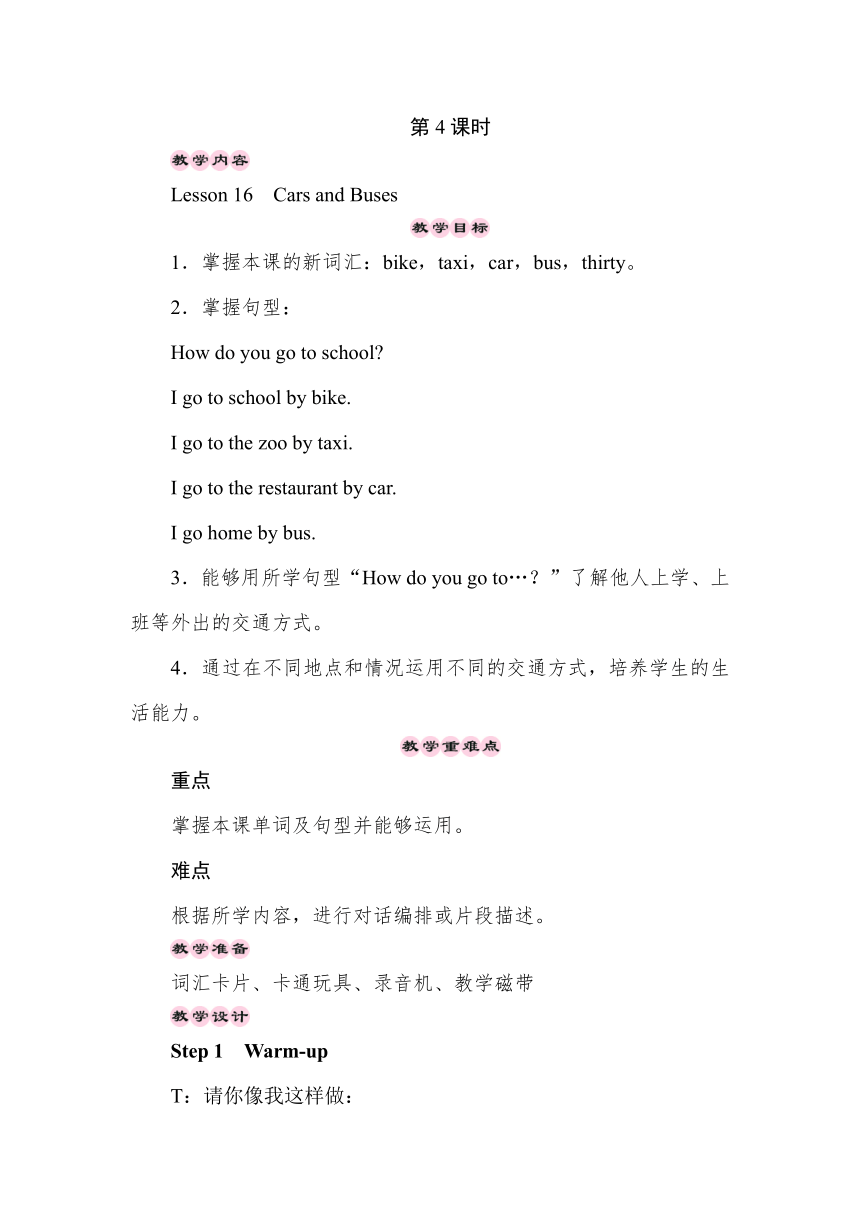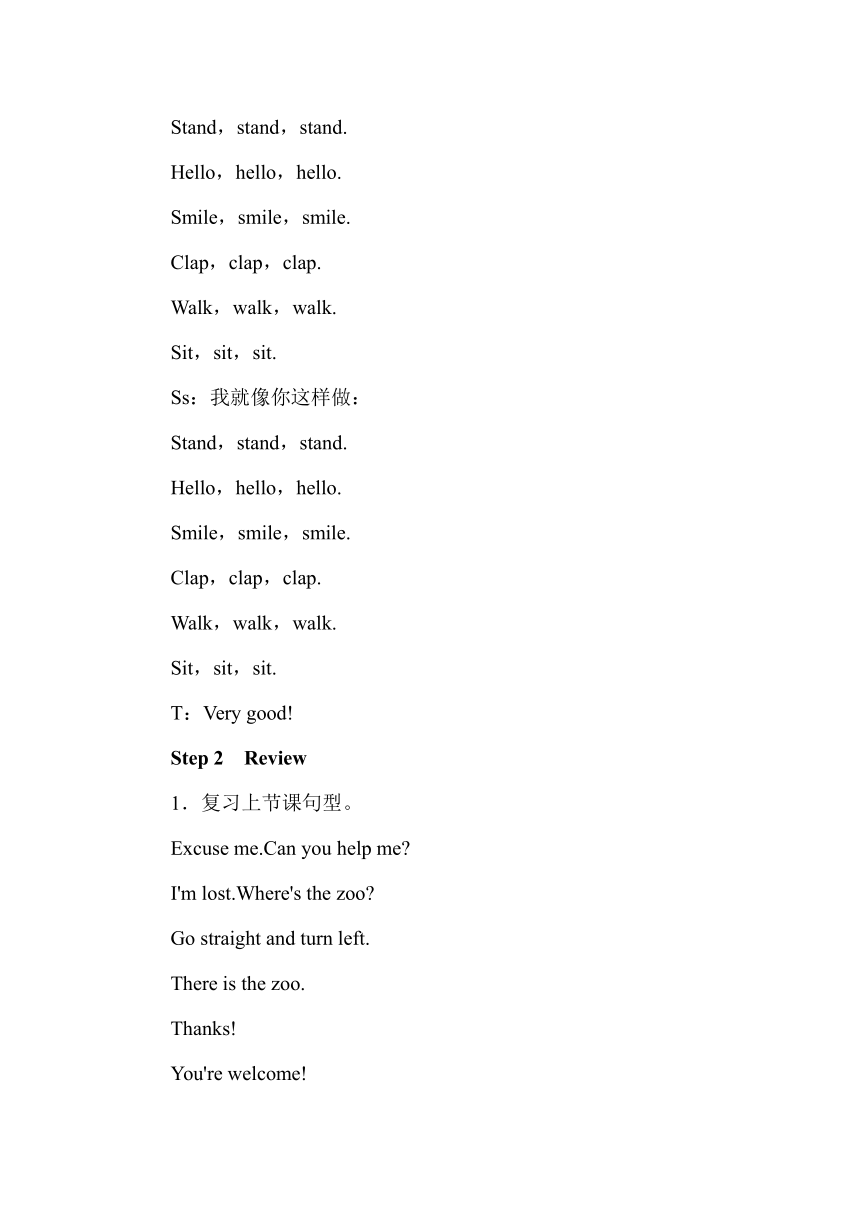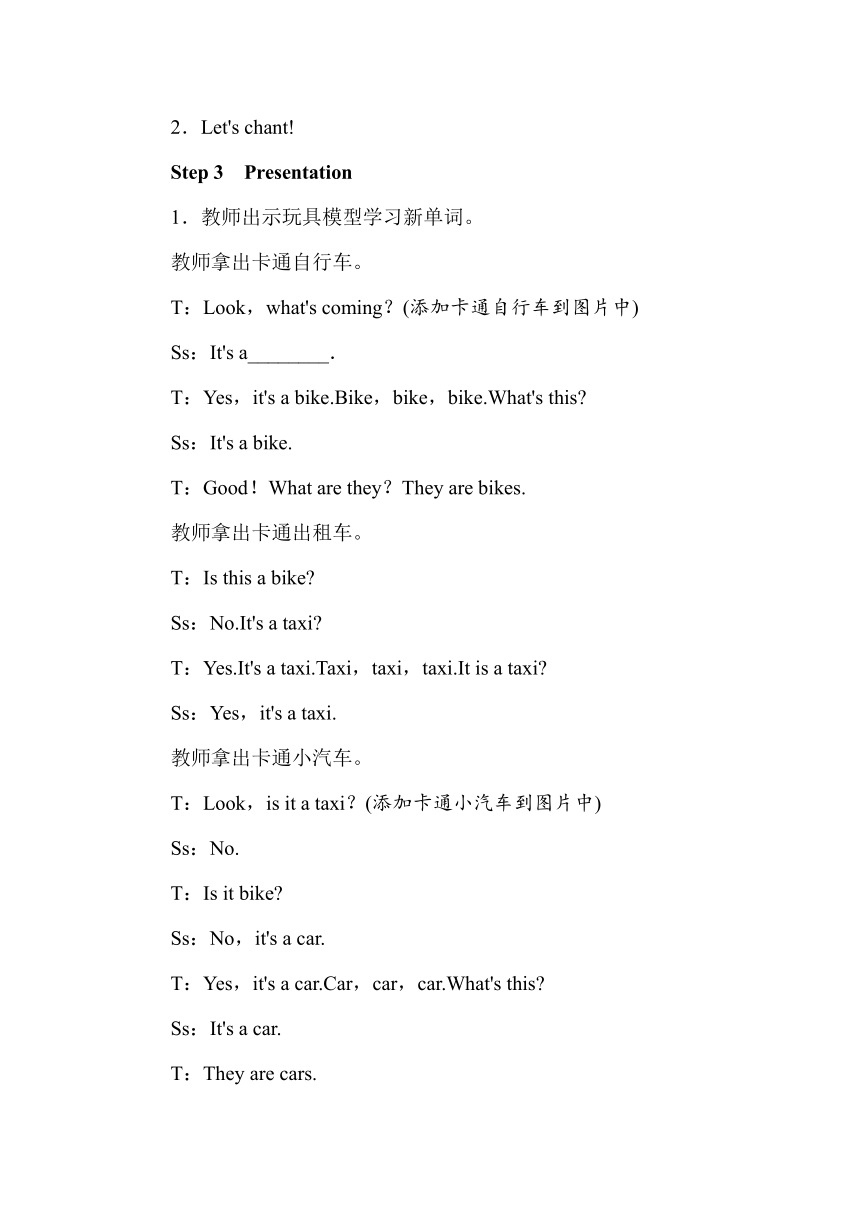Unit 3 Let's Go! Lesson 16 Cars and Buses 教案
文档属性
| 名称 | Unit 3 Let's Go! Lesson 16 Cars and Buses 教案 |  | |
| 格式 | doc | ||
| 文件大小 | 471.0KB | ||
| 资源类型 | 教案 | ||
| 版本资源 | 冀教版(三年级起点) | ||
| 科目 | 英语 | ||
| 更新时间 | 2021-09-22 19:36:03 | ||
图片预览



文档简介
第4课时
Lesson
16 Cars
and
Buses
1.掌握本课的新词汇:bike,taxi,car,bus,thirty。
2.掌握句型:
How
do
you
go
to
school?
I
go
to
school
by
bike.
I
go
to
the
zoo
by
taxi.
I
go
to
the
restaurant
by
car.
I
go
home
by
bus.
3.能够用所学句型“How
do
you
go
to…?”了解他人上学、上班等外出的交通方式。
4.通过在不同地点和情况运用不同的交通方式,培养学生的生活能力。
重点
掌握本课单词及句型并能够运用。
难点
根据所学内容,进行对话编排或片段描述。
词汇卡片、卡通玩具、录音机、教学磁带
Step
1 Warm?up
T:请你像我这样做:
Stand,stand,stand.
Hello,hello,hello.
Smile,smile,smile.
Clap,clap,clap.
Walk,walk,walk.
Sit,sit,sit.
Ss:我就像你这样做:
Stand,stand,stand.
Hello,hello,hello.
Smile,smile,smile.
Clap,clap,clap.
Walk,walk,walk.
Sit,sit,sit.
T:Very
good!
Step
2 Review
1.复习上节课句型。
Excuse
me.Can
you
help
me?
I'm
lost.Where's
the
zoo?
Go
straight
and
turn
left.
There
is
the
zoo.
Thanks!
You're
welcome!
2.Let's
chant!
Step
3 Presentation
1.教师出示玩具模型学习新单词。
教师拿出卡通自行车。
T:Look,what's
coming?(添加卡通自行车到图片中)
Ss:It's
a________.
T:Yes,it's
a
bike.Bike,bike,bike.What's
this?
Ss:It's
a
bike.
T:Good!What
are
they?They
are
bikes.
教师拿出卡通出租车。
T:Is
this
a
bike?
Ss:No.It's
a
taxi?
T:Yes.It's
a
taxi.Taxi,taxi,taxi.It
is
a
taxi?
Ss:Yes,it's
a
taxi.
教师拿出卡通小汽车。
T:Look,is
it
a
taxi?(添加卡通小汽车到图片中)
Ss:No.
T:Is
it
bike?
Ss:No,it's
a
car.
T:Yes,it's
a
car.Car,car,car.What's
this?
Ss:It's
a
car.
T:They
are
cars.
教师拿出卡通公共汽车。
T:Look,what's
that?Is
it
a
car?(添加卡通公共汽车到图片中)
Ss:No,it's
a
bus.
T:Yes,it's
a
bus.Bus,bus,bus.(teach
the
word“bus”)Is
it
a
bus?
Ss:Yes,it's
a
bus.
T:What
are
they?They
are
buses.
2.How
do
you
go
to
school?
(1)教师说自己拥有的交通工具,并出示一张自己骑车去学校的照片,引出本课的重点句型并板书。
I
go
to(the)school
by
bike.
接着出示另一种句型,教师说:
I
go
to
school
by
bike.
How
do
you
go
to
school?
引导学生用刚才练习的句子回答。并板书句子:
How
do
you
go
to
school?
(2)学生操练。
首先学生两人一组操练,然后展示。
(3)小组调查。
请同学们先调查一下他们的同学是怎样去上学的。学生用刚刚学过的对话,在小组内展开调查,调查学生的上学的情况。完成下列表格,然后进行展示。
—How
do
you
go
to
school?
—I
go
to
school
by
bike.
Name
Go(es)
to
school
by
Li
Lin
bus
Wang
Hui
car
How
do
you
go
to
school?
S1:I
go
to
school
by
bike.
S2:I
go
to
school
by
taxi.
S3:I
go
to
school
by
car.
S4:I
go
to
school
by
bus.
…
可补充其他交通方式。
(4)学生听课文第一部分的录音,跟读“How
do
you
go
to
school?”部分的内容。教师注意纠正学生错误的语音、语调。
(5)小组朗读课文,表演对话。
3.Numbers.
(1)借助单词卡片展示数字21到30的表达,并指读这些数字单词,让学生观察其中的规律。在发现规律之后,教师也可以顺便讲一下30之后的英文表达。
(2)播放课文录音,让学生跟读。
(3)播放有关数字的动画(详见视频资源),加深了解和认识。
(4)在幻灯片上播放一些图片,让学生来数,并用句型“How
many…are
there?”问答。如:
—How
many
donuts
are
there?
—Thirty!
(5)也可以将单独的数字卡片进行30以内的数字组合,让学生说出它们的英语表达。
Step
4 Practice
1.单词练习:看短语贴卡片游戏。
(1)教师依次出示画着不同交通工具的短语卡片,让学生迅速地贴在黑板上的“by”短语旁边,教师领读短语和句子“I
go
to
school
by…”。
(2)让全班同学起立,一起玩数字接龙的游戏,练习0到30的英文表达。
2.对话练习。
我是“小记者”:各小组推荐一人为“小记者”。然后整理汇报。
Reporter:How
do
you
go
to
school?
S1:I
go
to
school
by
bus.
Reporter:How
do
you
go
to
the
zoo?
S2:I
go
to
the
zoo
on
foot.
T:How
do
you
go
to
the
restaurant?
S3:I
go
to
the
restaurant
by
car.
Reporter:How
do
you
go
to
Canada?
S4:I
go
to
Canada
by
plane.
Step
5 Consolidation
and
extension
1.学生回家调查父母及其他亲戚的上班方式,准备下一节课做汇报。
如:My
father
and
Uncle
Wang
go
to
work
by
bus,because
it's
cheap.My
mother
go
to
work
on
foot,because…
2.做同步练习。
Unit
3 Let's
Go!
Lesson
16 Cars
and
Buses
How
do
you
go
to
school?
I
go
to
school
by
bike.
I
go
to
the
zoo
by
taxi.
I
go
to
the
restaurant
by
car.
I
go
to
home
by
bus.
Lesson
16 Cars
and
Buses
1.掌握本课的新词汇:bike,taxi,car,bus,thirty。
2.掌握句型:
How
do
you
go
to
school?
I
go
to
school
by
bike.
I
go
to
the
zoo
by
taxi.
I
go
to
the
restaurant
by
car.
I
go
home
by
bus.
3.能够用所学句型“How
do
you
go
to…?”了解他人上学、上班等外出的交通方式。
4.通过在不同地点和情况运用不同的交通方式,培养学生的生活能力。
重点
掌握本课单词及句型并能够运用。
难点
根据所学内容,进行对话编排或片段描述。
词汇卡片、卡通玩具、录音机、教学磁带
Step
1 Warm?up
T:请你像我这样做:
Stand,stand,stand.
Hello,hello,hello.
Smile,smile,smile.
Clap,clap,clap.
Walk,walk,walk.
Sit,sit,sit.
Ss:我就像你这样做:
Stand,stand,stand.
Hello,hello,hello.
Smile,smile,smile.
Clap,clap,clap.
Walk,walk,walk.
Sit,sit,sit.
T:Very
good!
Step
2 Review
1.复习上节课句型。
Excuse
me.Can
you
help
me?
I'm
lost.Where's
the
zoo?
Go
straight
and
turn
left.
There
is
the
zoo.
Thanks!
You're
welcome!
2.Let's
chant!
Step
3 Presentation
1.教师出示玩具模型学习新单词。
教师拿出卡通自行车。
T:Look,what's
coming?(添加卡通自行车到图片中)
Ss:It's
a________.
T:Yes,it's
a
bike.Bike,bike,bike.What's
this?
Ss:It's
a
bike.
T:Good!What
are
they?They
are
bikes.
教师拿出卡通出租车。
T:Is
this
a
bike?
Ss:No.It's
a
taxi?
T:Yes.It's
a
taxi.Taxi,taxi,taxi.It
is
a
taxi?
Ss:Yes,it's
a
taxi.
教师拿出卡通小汽车。
T:Look,is
it
a
taxi?(添加卡通小汽车到图片中)
Ss:No.
T:Is
it
bike?
Ss:No,it's
a
car.
T:Yes,it's
a
car.Car,car,car.What's
this?
Ss:It's
a
car.
T:They
are
cars.
教师拿出卡通公共汽车。
T:Look,what's
that?Is
it
a
car?(添加卡通公共汽车到图片中)
Ss:No,it's
a
bus.
T:Yes,it's
a
bus.Bus,bus,bus.(teach
the
word“bus”)Is
it
a
bus?
Ss:Yes,it's
a
bus.
T:What
are
they?They
are
buses.
2.How
do
you
go
to
school?
(1)教师说自己拥有的交通工具,并出示一张自己骑车去学校的照片,引出本课的重点句型并板书。
I
go
to(the)school
by
bike.
接着出示另一种句型,教师说:
I
go
to
school
by
bike.
How
do
you
go
to
school?
引导学生用刚才练习的句子回答。并板书句子:
How
do
you
go
to
school?
(2)学生操练。
首先学生两人一组操练,然后展示。
(3)小组调查。
请同学们先调查一下他们的同学是怎样去上学的。学生用刚刚学过的对话,在小组内展开调查,调查学生的上学的情况。完成下列表格,然后进行展示。
—How
do
you
go
to
school?
—I
go
to
school
by
bike.
Name
Go(es)
to
school
by
Li
Lin
bus
Wang
Hui
car
How
do
you
go
to
school?
S1:I
go
to
school
by
bike.
S2:I
go
to
school
by
taxi.
S3:I
go
to
school
by
car.
S4:I
go
to
school
by
bus.
…
可补充其他交通方式。
(4)学生听课文第一部分的录音,跟读“How
do
you
go
to
school?”部分的内容。教师注意纠正学生错误的语音、语调。
(5)小组朗读课文,表演对话。
3.Numbers.
(1)借助单词卡片展示数字21到30的表达,并指读这些数字单词,让学生观察其中的规律。在发现规律之后,教师也可以顺便讲一下30之后的英文表达。
(2)播放课文录音,让学生跟读。
(3)播放有关数字的动画(详见视频资源),加深了解和认识。
(4)在幻灯片上播放一些图片,让学生来数,并用句型“How
many…are
there?”问答。如:
—How
many
donuts
are
there?
—Thirty!
(5)也可以将单独的数字卡片进行30以内的数字组合,让学生说出它们的英语表达。
Step
4 Practice
1.单词练习:看短语贴卡片游戏。
(1)教师依次出示画着不同交通工具的短语卡片,让学生迅速地贴在黑板上的“by”短语旁边,教师领读短语和句子“I
go
to
school
by…”。
(2)让全班同学起立,一起玩数字接龙的游戏,练习0到30的英文表达。
2.对话练习。
我是“小记者”:各小组推荐一人为“小记者”。然后整理汇报。
Reporter:How
do
you
go
to
school?
S1:I
go
to
school
by
bus.
Reporter:How
do
you
go
to
the
zoo?
S2:I
go
to
the
zoo
on
foot.
T:How
do
you
go
to
the
restaurant?
S3:I
go
to
the
restaurant
by
car.
Reporter:How
do
you
go
to
Canada?
S4:I
go
to
Canada
by
plane.
Step
5 Consolidation
and
extension
1.学生回家调查父母及其他亲戚的上班方式,准备下一节课做汇报。
如:My
father
and
Uncle
Wang
go
to
work
by
bus,because
it's
cheap.My
mother
go
to
work
on
foot,because…
2.做同步练习。
Unit
3 Let's
Go!
Lesson
16 Cars
and
Buses
How
do
you
go
to
school?
I
go
to
school
by
bike.
I
go
to
the
zoo
by
taxi.
I
go
to
the
restaurant
by
car.
I
go
to
home
by
bus.
同课章节目录
- Unit 1 The Clothes We Wea
- Lesson 1 Skirt and Trousers
- Lesson 2 New and Old
- Lesson 3 Coat and Scarf
- Lesson 4 Shoes and Socks
- Lesson 5 Days of the Week
- Lesson 6 Betty's Clothes
- Unit 2 At Home
- Lesson 7 Homework
- Lesson 8 TV and phone
- Lesson 9 In the Bedroom
- Lesson 10 Brush and wash
- Lesson 11Toys
- Lesson 12 John and Jack
- Unit 3 Let's Go!
- Lesson 13 At School
- Lesson 14 Near and Fa
- Lesson 15 In the City
- Lesson 17 I'm Lost!
- Lesson 16 cars and Buses
- Lesson 18 Lost in the City.
- Unit 4 Shopping in the City
- Lesson 19 Let's go shopping
- Lesson 20 At the Shop
- Lesson 21 Cinema and Park
- Lesson 22 At the Supermarket
- Lesson 23 Shopping Online
- Lesson 24 Etta's Teddy Bea
